


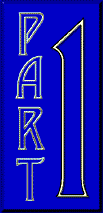
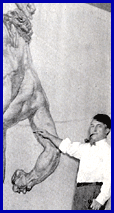

|
Issues 2,5,9,11 & 12 feature Pogany |
See his pen & ink work in issues # 1, 3 & 4 |
William Andrew (Willy) Pogany was gifted with myriad styles from which he selected the appropriate (or created a new) one for each book he illustrated.
| And he illustrated literally a hundred or more. Born in Hungary in 1882, he came to America in 1915 via Paris (two years) and London (ten years). Along the way he established himself as a premier illustrator of books. While in London, he crafted his quartet of masterpieces: Coleridge's The Rime of the Ancient Mariner (1910) and Wagner's Tannhauser (1911), Parsifal (1912) and Lohengrin (1913). Each of these is designed and executed completely by Pogany, from the covers and endpapers to the hand-calligraphed text to the pen & ink, pencil, wash, color and tipped-in color plates. The Coleridge was issued in a leather-bound limited edition, a trade edition and an American revised reprint in smaller format circa 1925. The Wagnerian trilogy was issued in a variety of bindings, all of which were quite ornate and all designed by Pogany. The interiors featured the same extravagant details and efforts as The Rime. The set shown below featured 1/4 leather spines and matching gilt-embossed cloth covers in a matching cloth-covered slipcase. |
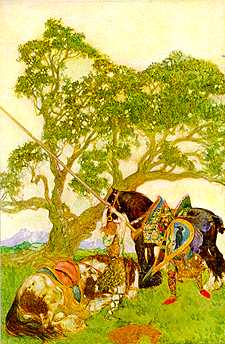 Parsifal (1912) |
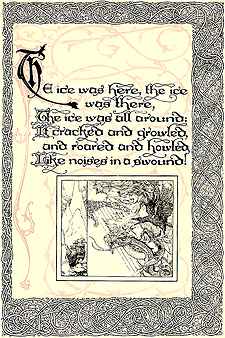 His
masterpiece has to be The Ancient Mariner. The large,
9.5" x 11.75", format allowed Pogany to pull out all
the stops. Each page is at least two colors, sometimes with a
gilt plate and usually an intricate border added. Extra-elaborate
initials started each page, with simply ornate capitals for the
beginning of each line (see the sample page at left). An illuminated
title page, 18 tipped-in color plates, the second color added
to the black and white plates, the flowing calligraphic text,
and the numerous pen & ink drawings throughout make this
extra special. His
masterpiece has to be The Ancient Mariner. The large,
9.5" x 11.75", format allowed Pogany to pull out all
the stops. Each page is at least two colors, sometimes with a
gilt plate and usually an intricate border added. Extra-elaborate
initials started each page, with simply ornate capitals for the
beginning of each line (see the sample page at left). An illuminated
title page, 18 tipped-in color plates, the second color added
to the black and white plates, the flowing calligraphic text,
and the numerous pen & ink drawings throughout make this
extra special. |
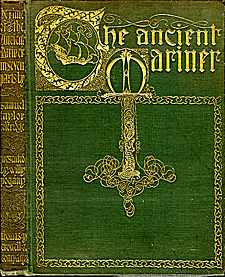 The Rime of the Ancient Mariner (1910) |
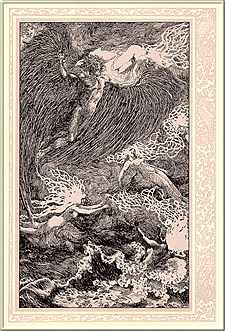 The soft ivory
paper and subtle lavender borders of Rime (see image at
right) and the three subtly different gray stocks of the Wagner
books add an additional depth to the presentations. Pogany used
both to good advantage, setting soft color pencil drawings against
the grays in Lohengrin (see samples reproduced in the
second issue of my magazine, The
Vadeboncoeur Collection of ImageS) and using the paper
color as an added dimension in Tannhauser. The sheer variety
of media utilized in these four books is amazing. From ultra-soft
pastel pencil drawings to superb watercolor paintings and stylish
and stunning pen & ink, often with spot color added, Pogany
never seemed to tire of flexing another artistic muscle to make
these as impressive as any illustrated book of the day. Although
he never reached these heights of intricacy again, he showed
throughout his career that this stylistic variety was no fluke. The soft ivory
paper and subtle lavender borders of Rime (see image at
right) and the three subtly different gray stocks of the Wagner
books add an additional depth to the presentations. Pogany used
both to good advantage, setting soft color pencil drawings against
the grays in Lohengrin (see samples reproduced in the
second issue of my magazine, The
Vadeboncoeur Collection of ImageS) and using the paper
color as an added dimension in Tannhauser. The sheer variety
of media utilized in these four books is amazing. From ultra-soft
pastel pencil drawings to superb watercolor paintings and stylish
and stunning pen & ink, often with spot color added, Pogany
never seemed to tire of flexing another artistic muscle to make
these as impressive as any illustrated book of the day. Although
he never reached these heights of intricacy again, he showed
throughout his career that this stylistic variety was no fluke. |
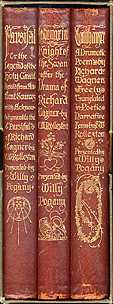 Wagner Trilogy (1911-13) |
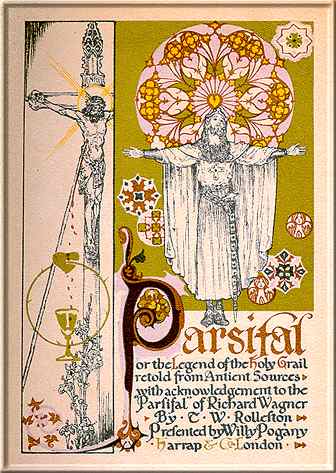 Parsifal Title Page (above) sample spread (below) 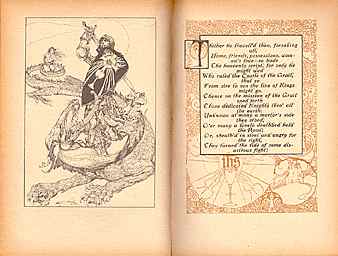 |
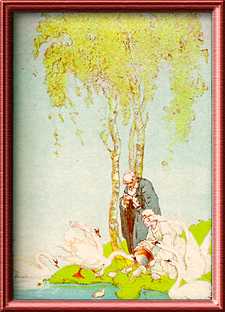 My favorite
aspects of all of his books are the pen & ink drawings. Don't
get me wrong, I really like the paintings, but there's a fluidity
and commanding presence demonstrated by his ink work, especially
in these early masterpieces, that is striking. Because of the
rich variety of styles found in these books, I decided to reduce
the size of the images to share more of them with you, starting
with the full-size title-page from Parsifal, at left and
two other images at right and above. And because the mix of styles
and media is so great, I've opted to show more than one image
from the books. My favorite
aspects of all of his books are the pen & ink drawings. Don't
get me wrong, I really like the paintings, but there's a fluidity
and commanding presence demonstrated by his ink work, especially
in these early masterpieces, that is striking. Because of the
rich variety of styles found in these books, I decided to reduce
the size of the images to share more of them with you, starting
with the full-size title-page from Parsifal, at left and
two other images at right and above. And because the mix of styles
and media is so great, I've opted to show more than one image
from the books.
Each of the three Wagner books is a treasure: with every page illuminated, hand-lettered, and with an ornate initial and a repeating background design, as you can see in the sample spread of two pages shown here. Add all of the color plates, both tipped-in and lithographic, and the richness of images is intense. Each book merits revisiting on a regular basis as new and beautiful aspects keep revealing themselves. These come highly recommended in the original editions. The smaller, later reprints are worth a look. The text is typeset and the format is smaller, but they are an acceptable substitute, especially when one considers the price. It appears that I will have to create a second Pogany page to share a reasonable cross-section of his work and styles. He did at least three different Rubaiyats (including one from 1909), three instructional books (Willy Pogany's Drawing Lessons, Willy Pogany's Oil Painting Lessons, and Willy Pogany's Water Color Lessons), many classics such as Alice in Wonderland, Faust and Mother Goose, a Hungarian Cookbook, and even a colorful children's book called Peterkin written by his wife, Elaine. He worked in film, magazines, murals, and more. Here are a few styles to keep you going until his turn comes up again for Part 2. |
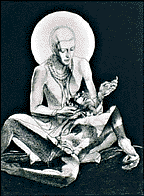
|
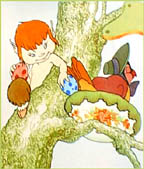
|
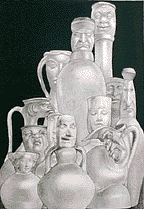
|
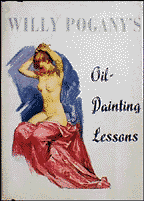 |
|
The Light of Asia (1932) |
Peterkin (1940) | Rubaiyat of Omar Khayyam (1942) | Willy Pogany's Oil Painting Lessons (1954) |

Click the portrait for a Pogany Autobiography
Courtesy of Ron Harris
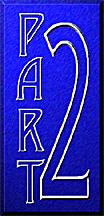
 To find out more about Willy Pogany see:
To find out more about Willy Pogany see:
| Fantastic Illustration and Design in Britain 1850-1930 | Diana L. Johnson, 1979 Rhode Island School of Design |
| Book Illustrators of the Twentieth Century | Brigid Peppin & Lucy Micklethwait, 1984 Arco |
| The Illustrator in America 1880-1980 | Walt and Roger Reed, 1984 Madison Square Press |
| Imaginative Book Illustration Society Newletter No. 1 | 1995 IBIS (lists 104 books in a prelimary bibliography) |
| IBIS Journal 1 - Aspects of Illustration | Robin Greer, 1999 Imaginative Book Illustration Society |
| The Vadeboncoeur Collection of Knowledge | Jim Vadeboncoeur, Jr. 1997 |
| The Vadeboncoeur Collection of ImageS 2,5,9,11,12, B&W 1,3,4 | Jim Vadeboncoeur, Jr. 2001-2003, 2006-2010, JVJ Publishing |
|
Illustrations copyright by their respective
owners. This page written, designed & © 1997 by Jim Vadeboncoeur, Jr. Updated 2001, 2011. |
Learn about other ILLUSTRATORS
